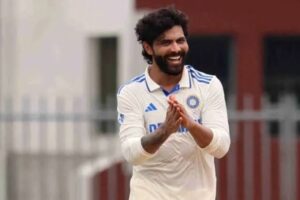
Shamik Chakrabarty in Kanpur
The most interesting part of Ravindra Jadeja joining the 300-Test-wicket club is that when he made his Test debut in 2012, it never felt like he would get there. Rather, he was ridiculed at the time for being his captain’s (MS Dhoni) favourite. For a long time, the “bits and pieces” tag was attached to him and the left-arm spinner from Saurashtra had to live with it until he elevated his cricket to the level of a world-class all-rounder. Jadeja reached the next level by dint of his hard work.
On Monday, on the fourth day of the second Test between India and Bangladesh here in Kanpur, Jadeja became the second-fastest cricketer after Ian Botham to achieve the elite double of 3,000 Test runs and 300 wickets. Botham did it in 72 matches. Jadeja reached the milestone in his 74th game. Khaled Ahmed was his 300th scalp.
Shane Warne, who else, identified the talent and gave Jadeja the sobriquet ‘Rockstar’. That was during the 2008 IPL. In fact, during his early days, Jadeja never looked like a Test bowler, let alone making a mark in the longer format and gradually becoming one of India’s all-time greats. In an all-time India Test XI, the 35-year-old will present a strong case for his inclusion. He has the second-best average, 23.98, and strike-rate, 58.1, after Ravichandran Ashwin (23.70 and 50.5), of the seven Indian bowlers with 300 or more Test wickets.
How did Jadeja get better, world-class in fact, as a bowler? He worked on his bowling and added more nuances to it. He learnt to vary his pace. Jadeja of the earlier vintage was good at bowling quick through the air and fizzing the ball off the deck. He still can get the better of a batsman through pace. But he can now do it by taking pace of the ball as well. During his evolution, Jadeja became a brilliant manipulator of the crease, using the entire depth and breadth of it. He also learnt the art of varying his angles. All the while, control remained the bedrock of his bowling.
“I have done well and I’m proud of myself,” Jadeja told the host broadcaster at the end of the day’s play today. “As a youngster, I started with white-ball cricket and everyone used to tell me I was a white-ball cricketer. But I worked hard with the red ball and finally all the hard work has paid off. Feeling happy and good. It’s special (300th Test wicket) and will forever remain with me.”
Having Ashwin at the other end helped. Pressure on the opposition was never released, especially in home conditions. As a partnership, the duo has taken 556 wickets in 55 Tests. Anil Kumble and Harbhajan Singh had 501 scalps from 54 Tests. Can Ashwin and Jadeja be called India’s best-ever spin partnership?
One of the fundamentals of performing art is that you don’t compare the greats. Things were entirely different when Bishan Singh Bedi and Erapalli Prasanna played. Cricket was basically a winter sport back then and India were not the game’s superpower. Kumble and Harbhajan rarely got dust-bowls. Nor did they have the advantage of DRS. For so long now, Ashwin and Jadeja have been immense and India’s bowling coach Morne Morkel tipped his hat to their partnership. He called Jadeja a “complete package”.
Jadeja likes to lead a high life, with his horses and flashy cars. On the field, however, he is a workhorse. He revels in his simple approach to the game.





